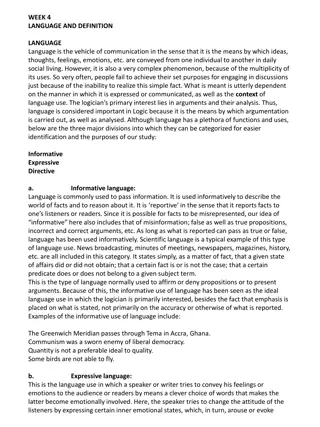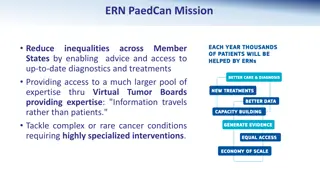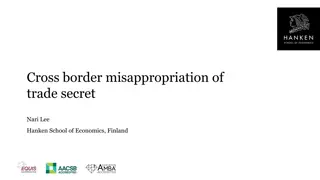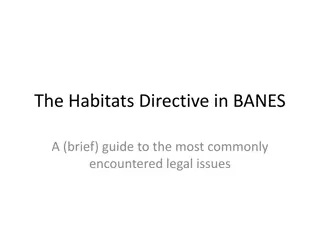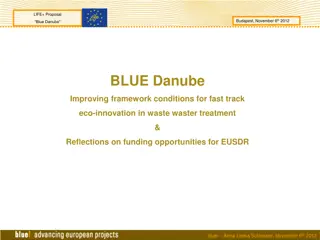Proposal for Directive to Enhance Working Conditions in Platform Work
The proposal aims to address challenges in platform work, including employment status classification and algorithmic management issues. It seeks to improve transparency, fairness, and accountability in algorithmic decision-making, correctly determine employment status, enhance transparency in platform work, and support sustainable growth of digital labor platforms in the EU.
Download Presentation

Please find below an Image/Link to download the presentation.
The content on the website is provided AS IS for your information and personal use only. It may not be sold, licensed, or shared on other websites without obtaining consent from the author.If you encounter any issues during the download, it is possible that the publisher has removed the file from their server.
You are allowed to download the files provided on this website for personal or commercial use, subject to the condition that they are used lawfully. All files are the property of their respective owners.
The content on the website is provided AS IS for your information and personal use only. It may not be sold, licensed, or shared on other websites without obtaining consent from the author.
E N D
Presentation Transcript
Commission proposal for a Directive on Improving working conditions in platform work Economic and Social Committee 18 February 2022 Max Uebe DG EMPL
Platform work by the numbers 28 million people estimated to do platform work in the EU today (6 million on-location ,22 million online ). In 2025, increase to 43 million people. More than 500 digital labour platforms active in the EU. Revenues have grown 500% over the past five years. 92% of platforms work with self-employed. 5.5 million people might be erroneously classified as self-employed . More than 120 court decisions on employment status in 12 Member States. 55% of people on platforms earn less than the minimum wage. People on platforms do an average of 9 hours per week of unpaid work.
Challenge No 1: Employment status Worker status is the gateway to labour rights (and social protection) Most Terms & Conditions categorise people as self-employed Direction and control through algorithms risk of misclassification Court claims on reclassification rather successful Uncertainty over applicable rules
Challenge No 2: Algorithmic management Algorithms carrying out managerial tasks: Automated decision-making ( black boxes ): task allocation, bonuses, penalties, ratings, etc. Surveillance: location, activity, output Impact on earnings and ratings assessment Problem: insufficient transparency, human oversight and remedies Largely unaddressed in labour law
The proposed Directive: objectives Improve the working conditions of persons performing platform work by promoting transparency, fairness and accountability in algorithmic management ensuring correct determination of their employment status improving transparency in platform work, including in cross-border situations while supporting the conditions for the sustainable growth of digital labour platforms in the Union.
The proposed Directive: main provisions rebuttable presumption of employment relationship (including shift in the burden of proof) new set of rights for people subject to algorithmic management on platforms obligations for platforms to provide information on people working through them and their terms and conditions
Scope Individuals every person performing platform work in the Union who has, or who based on an assessment of facts may be deemed to have, an employment relationship who does not have an employment contract or employment relationship => only certain rights in relation to algorithmic management Platforms digital labour platforms organising platform work performed in the Union irrespective of their place of establishment
Definition Digital labour platform Provider of a commercial service : internet-based provided at the request of a client involves the organisation of work performed by individuals, online or in a certain location Organisation of work significant role in matching demand and supply of labour Excludes: online business directories, job adverts etc.
Rebuttable presumption legal presumption of employment relationship for digital labour platforms that control the performance of work (cf. criteria next slide) applicable in all relevant administrative and legal proceedings no retroactive effect MS supporting measures: information for the public guidance for platforms and people performing platform work (incl. procedures for rebuttal) and for enforcement authorities controls and field inspections
Presumption criteria controlling the performance of work a) effectively determining, or setting upper limits for the level of remuneration; b) requiring the person performing platform work to respect specific binding rules with regard to appearance, conduct towards the recipient of the service or performance of the work; c) supervising the performance of work or verifying the quality of the results of the work including by electronic means; d) effectively restricting the freedom, including through sanctions, to organise one s work, in particular the discretion to choose one s working hours or periods of absence, to accept or to refuse tasks or to use subcontractors or substitutes; e) effectively restricting the possibility to build a client base or to perform work for any third party. fulfilling at least two criteria will trigger the presumption
Algorithmic management new rights Automated monitoring and decision-making systems transparency (type of actions monitored/evaluated, automated decisions, main parameters) restriction of data use (e.g. while not working) human monitoring of automated systems review of significant decisions (obtain explanations, access to contact person, request to review decisions, reply within one week) information and consultation of representatives
Transparency on platform work Digital labour platforms which are employers must: declare work performed by platform workers All digital labour platforms must: make available information to labour, social protection and other authorities + worker representatives about: number of persons performing platform work contractual or employment status terms and conditions
Enforcement provisions Standard enforcement provisions Access to evidence Communication channels Possibility for persons performing platform work to contact and communicate with each other + be contacted by representatives through the digital infrastructure of the digital labour platform




